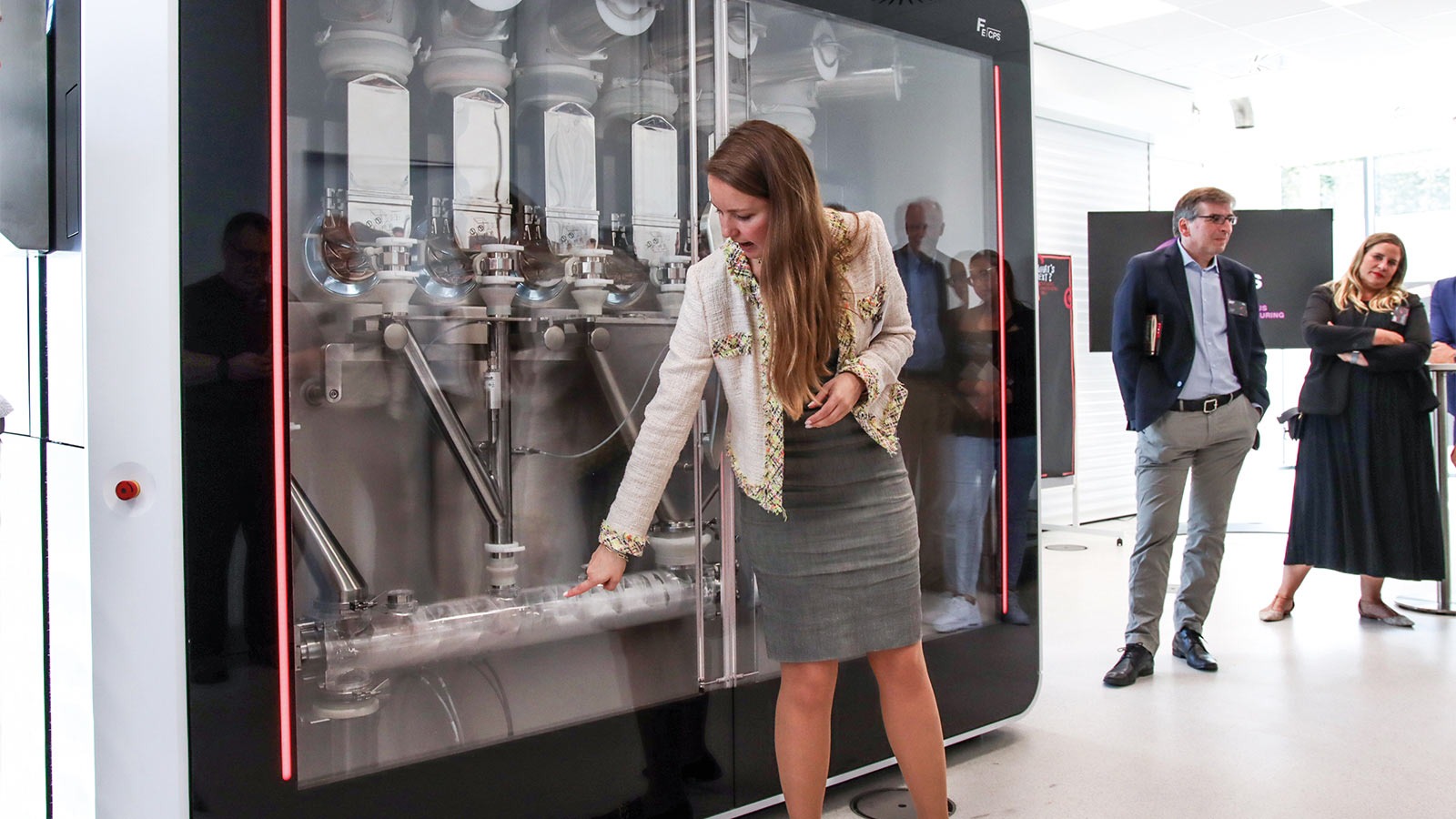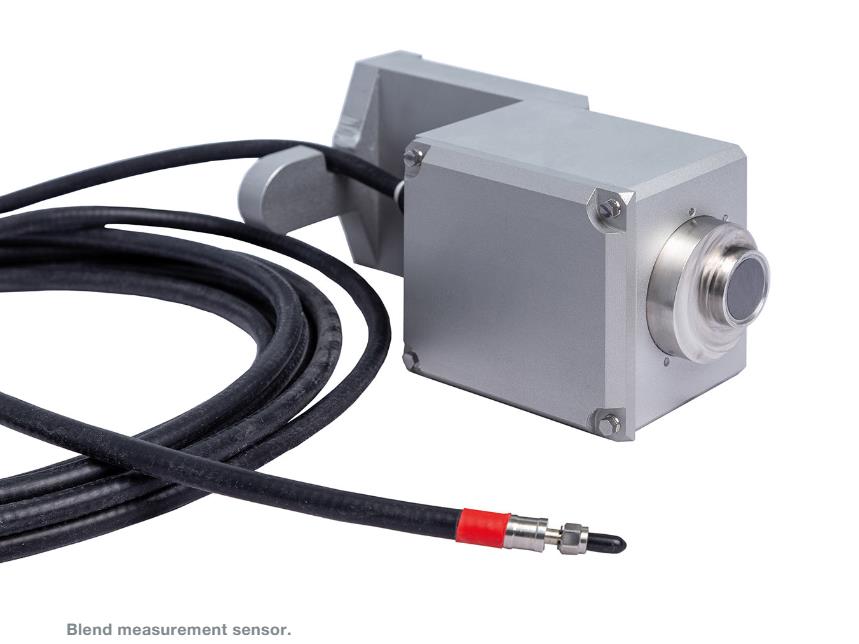
[Translate to English:] Auf dem Continuous Manufacturing Circle im Sommer 2022 stellte Dr. Anna Novikova erstmals vor, an welchen Stellen der FE CPS ePAT-Messungen durchgeführt werden können.
Dr. Novikova, what is the significance of PAT for tableting?
Some pharmacists and process experts say: “Efficient production will only succeed with PAT.” This shows just how important the analysis of production processes has become. With the right technology, processes can be better understood and controlled, which becomes a decisive criterion, especially in continuous plants. In this context, PAT has the potential to increase product quality and process efficiency, shorten time-to-market, and save money. However, the fact remains that PAT has not yet become widely accepted.
Why is that?
Users often express concerns about the potentially high effort required for setup and the difficult handling for operators. In fact, third-party equipment and programs are still often used, which can only be handled safely and efficiently by specialists. The software is usually only slightly integrated into the production line or not integrated at all, resulting in the high effort required to implement the PAT system. Instead, many users stick to time-consuming laboratory tests or struggle with complicated predictions about residence time distribution models that have to be set up first and then validated at great expense.
How do you counter these concerns?
We have been working extensively with process analytical techniques for years and have developed a solution for Continuous Manufacturing that is both simple and efficient. For example, the Direct Compression line with the FE CPS has a new type of technology for inline process analysis that we have called ePAT – embedded Process Analytical Technology. Here, highly-sophisticated sensors are integrated into the process units and permanently monitor the decisive quality attributes. The measurements are taken directly in the product flow and allow the production process to be adjusted quickly if necessary.
How does this embedding work?
The measurement technology is fully embedded in the control system, which means that the sensor spectrometers are directly connected to the machine’s integrated controller. Via sensors for near-infrared spectroscopy, or NIRS for short, product quality can thus be monitored in real time. The entire measurement system has become very simple and reproducible with ePAT, with full mechanical and digital integration. We have equipped the line with watchful eyes that monitor all relevant process steps at all times. Thanks to their integration, we can now measure like we have never measured before.
»THE ENTIRE MEASUREMENT SYSTEM HAS BECOME VERY SIMPLE AND REPRODUCIBLE WITH EPAT, WITH FULL MECHANICAL AND DIGITAL INTEGRATION. WE HAVE EQUIPPED THE LINE WITH WATCHFUL EYES THAT MONITOR ALL RELEVANT PROCESS STEPS AT ALL TIMES.«
Dr. Anna Novikova, Manager Application Center, Pharmacist at Fette Compacting
What are the benefits for users?
They get a precise tool with ultra-short measurement times that is absolutely cGMP-compliant, right down to method management, i.e. complies with current Good Manufacturing Practice in pharmaceutical production. Other advantages include the industrially robust design, the tool-free installation and removal, the ease of operation via the Human Machine Interface of the tablet press, and the equally simple cleaning of the sensors.

Sensors for ePAT are available at several measurement positions.
Where is the sensor technology installed in the system?
There are several possible measurement points, and a distinction must be made between two basic types of measurement: First, we measure the blend uniformity (BU). This is done with an active measuring head that can be mounted at various positions, from the outlet of the blender through the inlet of the tablet press and the Fill-O-Matic, to the process chamber of the tablet press. Secondly, we record the active ingredient concentration of the tablets. This measurement, which takes place at the tablet discharge on the die table, allows 100 percent inspection, including rejection of individual tablets that do not meet specifications.
How is it decided at which measuring points sensors are required?
That depends on the manufacturer’s objective. For example, if we are talking about the research and development phase, the goal is to collect as much data as possible and learn everything about the processes. In this case, we equip several measuring points and possibly use an additional NIRS Checkmaster that can be easily connected to the Direct Compression line. If we are already mid-production and know the process flows, the question is more likely to be, which measuring points are still relevant for quality control. As a rule, one or two sensors are sufficient in ongoing production to continuously control critical steps.


Why do you use near-infrared spectroscopy for this?
It has proven to be particularly efficient among measurement methods. Its main advantage is that the spectral range from 750 to 2,200 nanometers covers most different active ingredients. The near-infrared rays penetrate deep into the tablet without damaging it. Ultra-fast quality checks on larger sample volumes are feasible with NIRS, which is why the method is so well suited for Continuous Direct Compression. In addition, the same NIRS measurement provides information on both the chemical and certain physical properties of a sample. The ingredient concentration of active formulations can thus be determined just as reliably as other factors, such as density and moisture content.
How was the control system integrated?
With the FE CPS, a single control system performs all machine, process and quality control functions, regardless of whether the unit is run in stand-alone mode or as part of a continuous plant. The system control architecture consists of a high-speed embedded controller and an industrial PC for the operator terminal, including central management of the recipe and the spectroscopic method as well as the reporting. We have combined this simplified hardware architecture with Fette Compacting’s tried-and-tested software. This ultimately reduces validation efforts and results in a robust, reliable control system.
What do you recommend to manufacturers interested in ePAT?
Let us sound out at an early stage whether and how integrated process analysis is suitable for your projects! At the beginning of the consulting process, the question usually arises of how exactly the quality of a product is defined. On this basis, we can develop lean processes and find ways to move away from expensive laboratory work to real-time process analysis. During product trials, we test sensors at several measuring points and thus work our way to the appropriate measuring system. We also assist users with the subsequent calibration of the sensors and ensure overall that they exploit the full efficiency potential of their continuous tableting.





